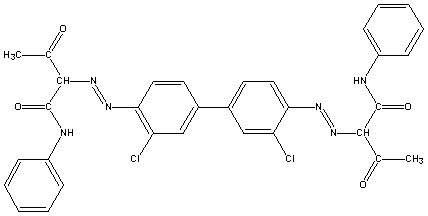
NTP Study Reports

NTP Study Reports
Home » Study Results & Research Projects » NTP Study Reports » All Long-Term Reports » Abstract for TR-30 - Diarylanilide Yellow

Diarylanilide yellow, one member of a family of organic azo pigments known as benzidine yellows, was selected for bioassay by the National Cancer Institute in an attempt to elucidate those dyes and dye intermediates which may be responsible for the increased incidence of bladder cancer observed among workers in the dye manufacturing industry.
A bioassay of technical-grade diarylanilide yellow for possible carcinogenicity was conducted using Fischer 344 rats and B6C3F1 mice. Diarylanilide yellow was administered in the feed, at either of two concentrations, to groups of 50 male and 50 female animals of each species. The high and low dietary concentrations used in the chronic study for the male and female rats and mice were 5.0 and 2.5 percent, respectively, of the chemical in the feed. After a 78-week treatment period, observation of the rats continued for an additional 28 weeks and observation of the mice continued for an additional 19 weeks for high dose males and low and high dose females and 18 weeks for low dose males. For each species, 50 animals of each sex were placed on test as controls, and fed only the basal diet.
The high concentration administered to both species in this study was the maximum recommended in the Guidelines for Carcinogen Bioassay in Small Rodents. These guidelines indicate that a chronic dietary level of 5 percent, or 50,000 ppm, should not be exceeded even when no signs of toxicity are observed during subchronic testing, except under special circumstances (e.g., when the compound is a major component of the human diet). No toxic effects were reported during subchronic testing and diarylanilide yellow did not qualify for exception; therefore, the highest permissible concentration (5 percent) was utilized in the chronic bioassay.
The dietary concentrations of diarylanilide yellow administered during the chronic bioassay had no significant effect on survival or body weight gain in either species. Except for yellow staining and some isolated neoplasms, the only adverse clinical sign or pathologic lesion observed in treated rats or mice was basophilic cytoplasm changes in hepatocytes of treated rats.
In both species the survival in all groups was adequate for statistical analysis of late-appearing tumors.
No treatment-related increase in the incidence of neoplasms or nonneoplastic lesions was evident in treated rats or mice. A few unusual findings were observed in both species, including single cases of metastatic chordoma and osteogenic sarcoma in rats, and single cases of squamous-cell carcinoma of the ear, infiltrating duct carcinoma of the mammary gland, and subcutaneous mastocytoma in mice.
The results of the study did not provide evidence for the carcinogenicity of diarylanilide yellow in Fischer 344 rats or B6C3F1 mice.
Synonyms: 2,2'-[(3,3'-dichloro(1,1'-biphenyl)-4,4'-diyl)-bis (azo)] bis(3-oxo-N-phenyl)-butanamide; C.I. Pigment Yellow 12; Diarylide yellow
Levels of Evidence of Carcinogenicity:
Male Rats: Negative
Female Rats: Negative
Male Mice: Negative
Female Mice: Negative
Report Date: 1978
Target Organs from 2-year Studies
You may link to the full technical report in pdf format ( Note: A print ready copy of the document is presented in Portable Document Format (pdf) which requires the Acrobat Reader plug-in -- download a free copy of the reader.)
Web page last updated on October 15, 2007
The National Institute of Environmental Health Sciences is one of the National Institutes of Health within the U.S. Department of Health and Human Services. The National Toxicology Program is headquartered on the NIEHS campus in Research Triangle Park, NC.